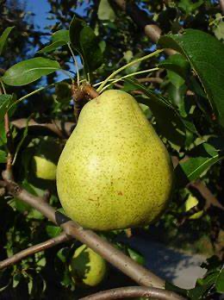Written by Tory Schmidt, Project Manager, WTFRC. Revised April 6, 2020
 In the face of relentlessly increasing labor costs and frequently disappointing returns, many pear growers are looking for ways to reduce their input costs and improve their packouts. For most pear varieties, the main challenge for crop load management is to set a full crop year in and year out, but like most apple cultivars, Bartlett pears can overset and typically need to be thinned in order to produce annual crops of good size and quality. Hand thinning is always an effective option at reducing fruit set, but very expensive and typically occurs later in the growing season after the trees have already invested a lot of water, carbohydrates, and nutrients into fruitlets that will be discarded; if Bartlett growers can adjust their crop loads earlier in the season, their trees won’t waste as many resources and should ultimately produce larger, better quality fruit.
In the face of relentlessly increasing labor costs and frequently disappointing returns, many pear growers are looking for ways to reduce their input costs and improve their packouts. For most pear varieties, the main challenge for crop load management is to set a full crop year in and year out, but like most apple cultivars, Bartlett pears can overset and typically need to be thinned in order to produce annual crops of good size and quality. Hand thinning is always an effective option at reducing fruit set, but very expensive and typically occurs later in the growing season after the trees have already invested a lot of water, carbohydrates, and nutrients into fruitlets that will be discarded; if Bartlett growers can adjust their crop loads earlier in the season, their trees won’t waste as many resources and should ultimately produce larger, better quality fruit.
Chemical thinning could be a viable option, but there are two major issues which render this approach more complex for pear growers than for typical apple production systems. First, a significant portion of Bartlett trees in the Pacific Northwest are interplanted among other pear varieties like D’Anjou and Bosc which often struggle with fruit set, making the Bartletts very difficult to spray with chemical thinners which can easily drift onto adjacent trees with undesirable effects. Secondly, there are fewer proven products registered as chemical thinners of pear, which limits both the time window for application and the types of specific thinning scenarios that could be successfully exploited.
Through the years, apple growers have had several options for chemical bloom thinners including some products no longer registered (i.e. Elgetol, Thinex, WilThin, ThinRite) and the current industry standard, lime sulfur. These products could reduce set by damaging exposed flower parts, but no such products have been registered for pear thinning. Technically, some naphthalene acetic acid (NAA) product labels allow application on pear as soon as full bloom/early petal fall, but they are intended to trigger a hormonal response in the floral structures, not to inflict physical damage. That means that the only currently legal options for chemical thinning of pear in the Pacific Northwest are limited to a few bioregulators which can be applied once bloom has concluded: the auxins NAA and its cousin naphthaleneacetamide (NAD), abscisic acid (ABA), and the cytokinins benzyladenine (BA) and forchlorfenur, also known as CPPU.
Here is a brief overview of those products which are registered for chemical thinning of pear (specifically Bartlett), as well as some developmental products that have been tested in PNW research trials.
Bloom Thinners
| Active ingredient: | Ammonium thiosulfate (ATS) |
| Registration status: | Fertilizer, not registered for thinning |
| Comments: | |
| Much like research trials in apple, 4-5% rates of ATS have been reasonably effective in Washington Tree Fruit Research Commission (WTFRC) field trials on Bartlett. The presumed mode of action of this fertilizer is to desiccate the stigmas of flowers, inhibiting the successful germination of pollen grains on their surface. ATS has potential appeal as a thinner because it is relatively inexpensive, safe for workers, and easy to handle. | |
| Active ingredient: | Urea |
| Registration status: | Fertilizer, not registered for thinning |
| Comments: | |
| Urea is a popular nitrogen-rich fertilizer sometimes used in ground applications in pear orchards. Like ATS, it is relatively inexpensive, easy to handle, and presumably works by damaging sensitive structures in pear flowers. While urea never reduced fruit set in WTFRC trials, 5% rates did occasionally improve fruit size, perhaps in part due to a fertilizer nutrient effect. | |
| Active ingredient: | Calcium polysulfide (lime sulfur) |
| Registration status: | Fertilizer, not registered for thinning in pear |
| Comments: | |
| Lime sulfur is registered for several uses in tree fruit, including chemical bloom thinning of apple. Like other bloom thinners, it damages floral structures, but also can induce temporary carbohydrate stress in fruit trees which can lead to additional thinning. In WTFRC trials, 4-6% lime sulfur was occasionally effective at reducing Bartlett fruit set, but unlike in apple studies, tank mixing of lime sulfur with various spray oils did not increase efficacy in pear. Incidentally, lime sulfur applied during bloom in apple trials has been somewhat effective against the pathogens which cause powdery mildew and fire blight, which could increase its appeal as a potential thinner in pear. | |
Postbloom Thinners
| Active ingredient: | 6-benzyladenine (6-BA or BA) |
| Registration status: | Registered |
| Trade names: | MaxCel, Exilis |
| Comments: | |
| The response of fruit trees to plant growth regulators can be quite unreliable depending on several factors including weather. Even though the sample size was relatively small, BA products applied to Bartlett produced some of the most consistent responses ever observed from PGR products in WTFRC trials. BA significantly reduced fruit set roughly one third of the time and increased harvest fruit size in every trial where it was measured. Full label rates of BA are more likely to induce thinning than reduced rates (50-75%) which can still boost cell division and fruit growth when applied in warm conditions (70s and 80s) after petal fall. Even though these products are expensive, there is often clear benefit to the grower to using them if the right weather pattern presents itself. | |
| Active ingredient: | Naphthalene acetic acid (NAA) |
| Registration status: | Registered |
| Trade names: | Fruitone, PoMaxa, Refine, others |
| Comments: | |
| NAA has been available for decades and most veteran pear growers interested in chemical thinning have probably tried using NAA at some point. NAA can significantly overthin in conditions stressful to fruit trees (warm, cloudy weather after petal fall), but also can show no clear effects in cooler conditions, as was the case in numerous WFTRC field studies. NAA products have earned a reputation for being occasionally effective at thinning Bartletts but being difficult to dial in to produce the desired response in a given year. | |
| Active ingredient: | Naphthaleneacetamide (NAD) |
| Registration status: | Registered |
| Trade names: | Amid-Thin |
| Comments: | |
| NAD has not been tested widely in PNW pear thinning trials, so information on this product is limited. In apple, NAD is thought to act similarly but with less potency than its structural cousin NAA in terms of thinning, making it simultaneously less effective and safer in terms of reducing the risk of overthinning. | |
| Active ingredient: | N-(2-Chloro-4-pyridyl)-N′-phenylurea (CPPU) aka Forchlorfenur |
| Registration status: | Registered |
| Trade names: | Splendor |
| Comments: | |
| Like BA, CPPU is a cytokinin capable of promoting cell division in fruit which can ultimately boost fruit size above and beyond the effects of reduced crop load. CPPU is much more potent than BA, however, and is known to cause the formation of distorted pears at higher doses, much like it has in apple research studies around the world. It showed some potential to thin pears in recent Oregon State University (OSU) trials but has not been used much commercially due to its high cost and volatile responses. | |
| Active ingredient: | Abscisic acid (ABA) |
| Registration status: | Registered |
| Trade names: | ProTone |
| Comments: | |
| Unlike most other commercial bioregulators, the commercial form of ABA (ProTone) is approved for use in organic orchards. In OSU trials, it showed some activity in conditions that were too cool (temps in the 60s) to produce satisfactory results with BA products. ABA has received far more use in the table grape industry than in commercial pear blocks, likely due to its high cost and inconsistent thinning results. | |
| Active ingredient: | Metamitron |
| Registration status: | Registration process underway |
| Trade names: | NA |
| Comments: | |
| Metamitron is a proven chemical thinner of tree fruit around the world but has not yet achieved registration in the US. It has performed very well in thinning trials by WTFRC on apple and by OSU on Bartlett. Metamitron imposes a temporary inhibition of photosynthesis, making it particularly effective as a thinner in warm, cloudy weather. While the timing of full registration is uncertain, metamitron is expected to have a label for chemical thinning of some pears including Bartlett. | |
NOTE: Some of the pesticides discussed in this presentation were tested under an experimental use permit granted by WSDA. Application of a pesticide to a crop or site that is not on the label is a violation of pesticide law and may subject the applicator to civil penalties up to $7,500. In addition, such an application may also result in illegal residues that could subject the crop to seizure or embargo action by WSDA and/or the U.S. Food and Drug Administration. It is your responsibility to check the label before using the product to ensure lawful use and obtain all necessary permits in advance.
Use pesticides with care. Apply them only to plants, animals, or sites listed on the labels. When mixing and applying pesticides, follow all label precautions to protect yourself and others around you. It is a violation of the law to disregard label directions. If pesticides are spilled on skin or clothing, remove clothing and wash skin thoroughly. Store pesticides in their original containers and keep them out of the reach of children, pets, and livestock.
YOU ARE REQUIRED BY LAW TO FOLLOW THE LABEL. It is a legal document. Always read the label before using any pesticide. You, the grower, are responsible for safe pesticide use. Trade (brand) names are provided for your reference only. No discrimination is intended, and other pesticides with the same active ingredient may be suitable. No endorsement is implied.
Contact
 Tory Schmidt
Tory Schmidt
Project Manager
Washington Tree Fruit Research Commission
phone: 509-665-8271
email: tory@treefruitresearch.com
Treefruit.wsu.edu articles may only be republished with prior author permission © Washington State University. Republished articles with permission must include: “Originally published by Washington State Tree Fruit Extension Fruit Matters at treefruit.wsu.edu” along with author(s) name, and a link to the original article.
